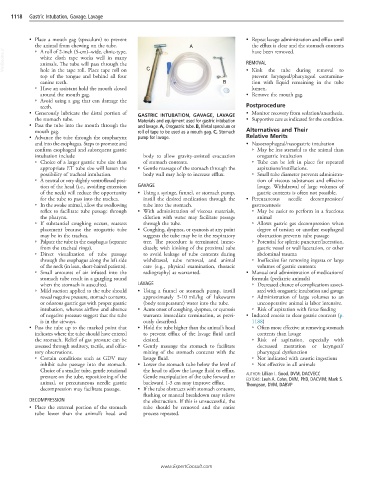Page 2246 - Cote clinical veterinary advisor dogs and cats 4th
P. 2246
1118 Gastric Intubation, Gavage, Lavage
• Place a mouth gag (speculum) to prevent • Repeat lavage administration and efflux until
the animal from chewing on the tube. A the efflux is clear and the stomach contents
VetBooks.ir white cloth tape works well in many REMOVAL
○ A roll of 2-inch (5-cm)–wide, clinic-type,
have been removed.
animals. The tube will pass through the
hole in the tape roll. Place tape roll on
top of the tongue and behind all four C • Kink the tube during removal to
prevent laryngeal/pharyngeal contamina-
canine teeth. B tion with liquid remaining in the tube
○ Have an assistant hold the mouth closed lumen.
around the mouth gag. • Remove the mouth gag.
○ Avoid using a gag that can damage the
teeth. Postprocedure
• Generously lubricate the distal portion of GASTRIC INTUBATION, GAVAGE, LAVAGE • Monitor recovery from sedation/anesthesia.
the stomach tube. Materials and equipment used for gastric intubation • Supportive care as indicated for the condition.
• Pass the tube into the mouth through the and lavage. A, Orogastric tube. B, Metal speculum or
mouth gag. roll of tape to be used as a mouth gag. C, Stomach Alternatives and Their
• Advance the tube through the oropharynx pump for lavage. Relative Merits
and into the esophagus. Steps to promote and • Nasoesophageal/nasogastric intubation
confirm esophageal and subsequent gastric ○ May be less stressful to the animal than
intubation include body to allow gravity-assisted evacuation orogastric intubation
○ Choice of a larger gastric tube size than of stomach contents. ○ Tube can be left in place for repeated
appropriate ET tube size will lessen the • Gentle massage of the stomach through the aspirations/instillations.
possibility of tracheal intubation. body wall may help to increase efflux. ○ Small tube diameter prevents administra-
○ A neutral or very slightly ventroflexed posi- tion of viscous substances and effective
tion of the head (i.e., avoiding extension GAVAGE lavage. Withdrawal of large volumes of
of the neck) will reduce the opportunity • Using a syringe, funnel, or stomach pump, gastric contents is often not possible.
for the tube to pass into the trachea. instill the desired medication through the • Percutaneous needle decompression/
○ In the awake animal, allow the swallowing tube into the stomach. gastrocentesis
reflex to facilitate tube passage through • With administration of viscous materials, ○ May be easier to perform in a fractious
the pharynx. dilution with water may facilitate passage animal
○ If substantial coughing occurs, reassess through the tube. ○ Allows gastric gas decompression when
placement because the orogastric tube • Coughing, dyspnea, or cyanosis at any point degree of torsion or another esophageal
may be in the trachea. suggests the tube may be in the respiratory obstruction prevents tube passage
○ Palpate the tube in the esophagus (separate tree. The procedure is terminated imme- ○ Potential for splenic puncture/laceration,
from the tracheal rings). diately, with kinking of the proximal tube gastric vessel or wall laceration, or other
○ Direct visualization of tube passage to avoid leakage of tube contents during abdominal trauma
through the esophagus along the left side withdrawal, tube removal, and animal ○ Ineffective for removing ingesta or large
of the neck (in lean, short-haired patients). care (e.g., physical examination, thoracic volumes of gastric contents
○ Small amounts of air infused into the radiography) as warranted. • Manual oral administration of medications/
stomach tube result in a gurgling sound formula (pediatric animals)
when the stomach is ausculted. LAVAGE ○ Decreased chance of complications associ-
○ Mild suction applied to the tube should • Using a funnel or stomach pump, instill ated with orogastric intubation and gavage
reveal negative pressure, stomach contents, approximately 5-10 mL/kg of lukewarm ○ Administration of large volumes to an
or odorous gastric gas with proper gastric (body temperature) water into the tube. uncooperative animal is labor intensive.
intubation, whereas airflow and absence • Acute onset of coughing, dyspnea, or cyanosis ○ Risk of aspiration with force feeding
of negative pressure suggest that the tube warrants immediate termination, as previ- • Induced emesis to clear gastric contents (p.
is in the airways. ously described. 1188)
• Pass the tube up to the marked point that • Hold the tube higher than the animal’s head ○ Often more effective at removing stomach
indicates where the tube should have entered to prevent efflux of the lavage fluid until contents than lavage
the stomach. Relief of gas pressure can be desired. ○ Risk of aspiration, especially with
assessed through auditory, tactile, and olfac- • Gently massage the stomach to facilitate decreased mentation or laryngeal/
tory observations. mixing of the stomach contents with the pharyngeal dysfunction
○ Certain conditions such as GDV may lavage fluid. ○ Not indicated with caustic ingestions
inhibit tube passage into the stomach. • Lower the stomach tube below the level of ○ Not effective in all animals
Choice of a smaller tube, gentle rotational the head to allow the lavage fluid to efflux.
pressure on the tube, repositioning of the Gentle manipulation of the tube forward or AUTHOR: Lillian I. Good, DVM, DACVECC
EDITORS: Leah A. Cohn, DVM, PhD, DACVIM; Mark S.
animal, or percutaneous needle gastric backward 1-3 cm may improve efflux. Thompson, DVM, DABVP
decompression may facilitate passage. • If the tube obstructs with stomach contents,
flushing or manual breakdown may relieve
DECOMPRESSION the obstruction. If this is unsuccessful, the
• Place the external portion of the stomach tube should be removed and the entire
tube lower than the animal’s head and process repeated.
www.ExpertConsult.com

